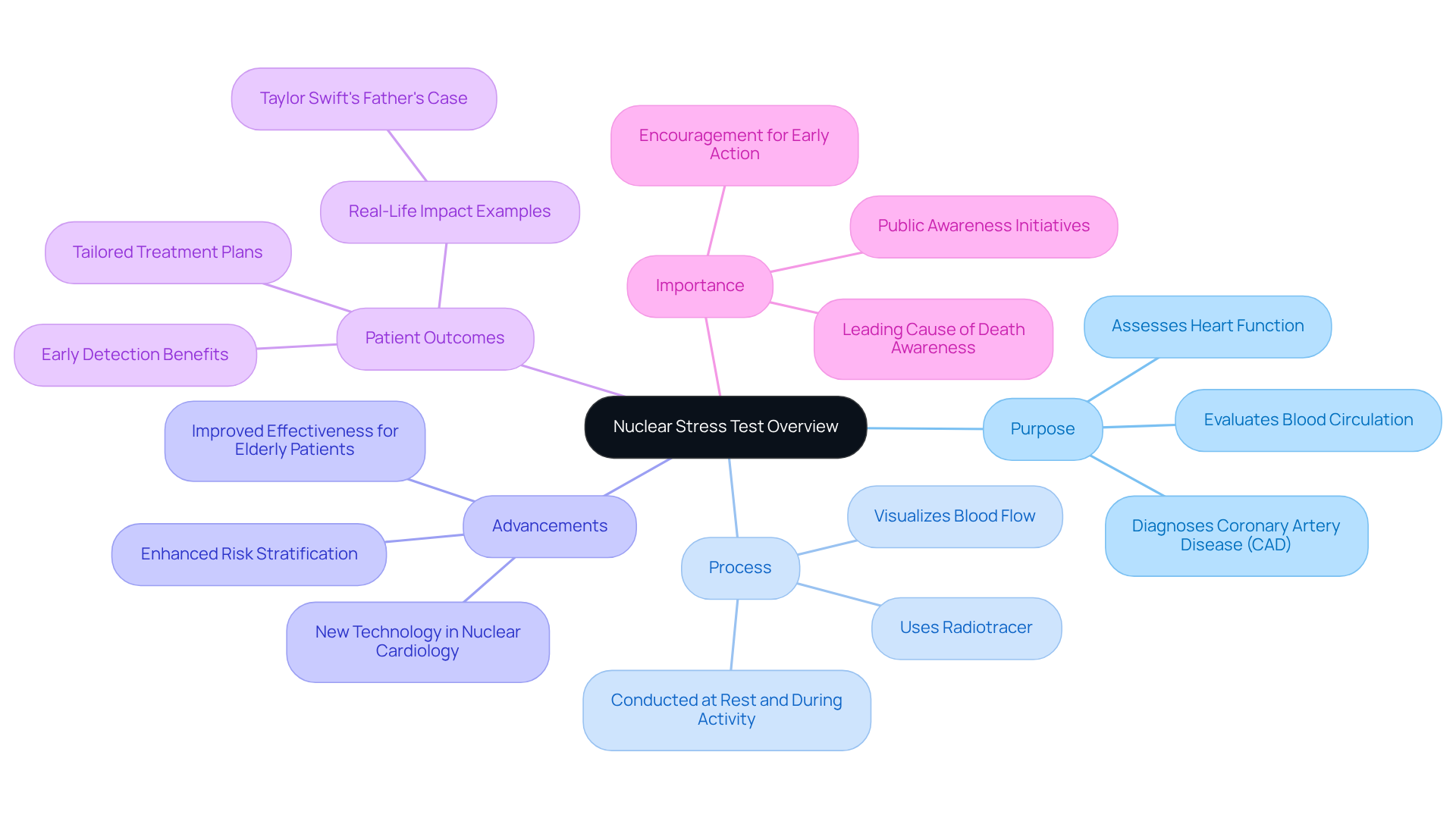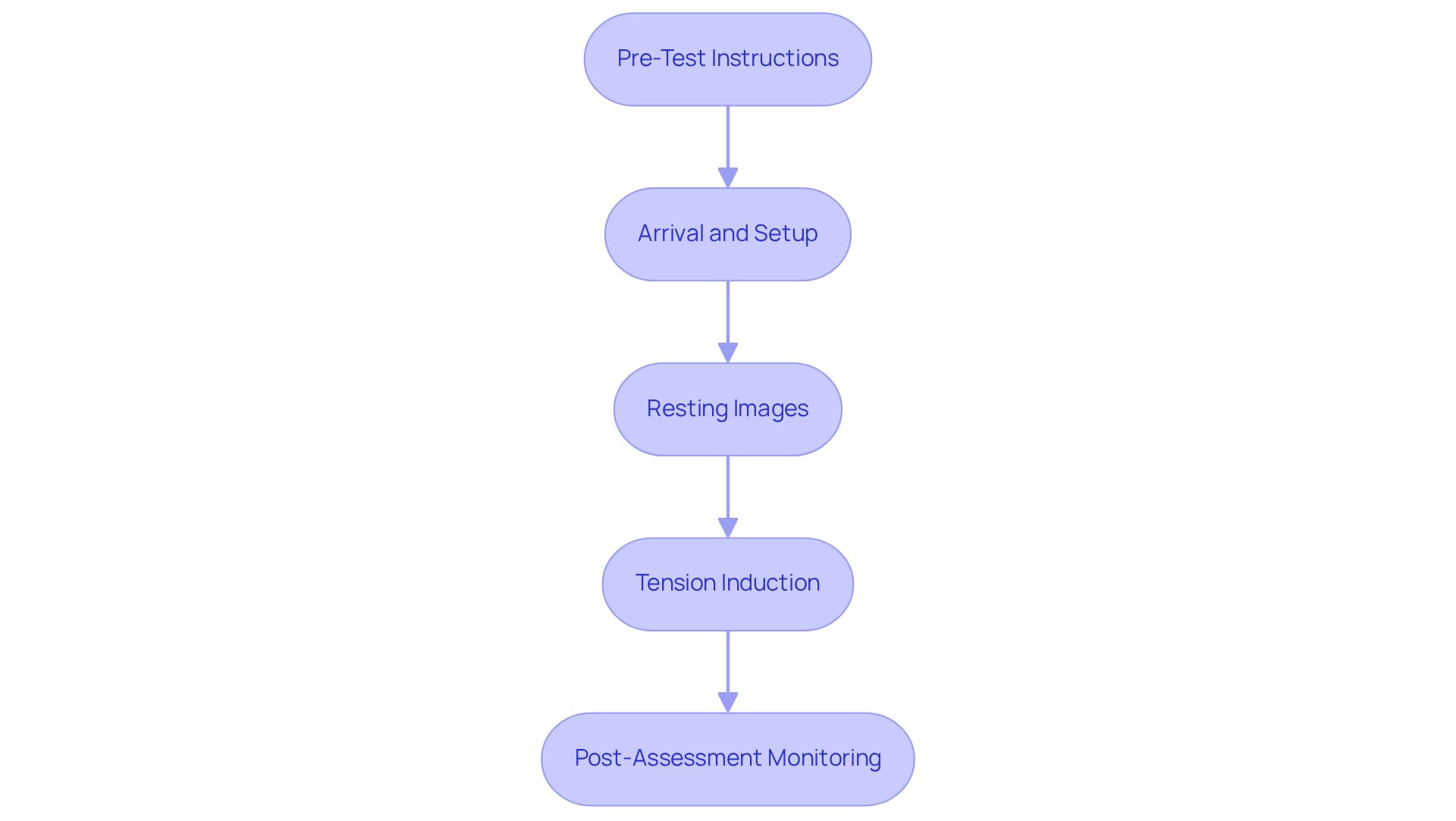


Understanding heart health can feel overwhelming, especially when cardiovascular diseases are a leading cause of mortality worldwide. It’s important to know that you’re not alone in this journey. The nuclear stress test is a vital tool that provides insights into blood flow and heart function, potentially saving lives. Yet, many people may wonder what to expect from this diagnostic procedure.
How can you navigate the preparation, execution, and interpretation of results while ensuring the best possible outcomes? This article aims to gently guide you through the essential aspects of the nuclear stress test. By equipping you with knowledge, we hope to empower you to make informed decisions about your heart health. Remember, understanding this process is a significant step toward early detection and personalized treatment strategies.
During a nuclear stress test what to expect is a vital diagnostic imaging process that evaluates blood circulation to the heart muscle while at rest and during physical activity. This test uses a small amount of radioactive material, called a radiotracer, injected into the bloodstream. It plays a crucial role in diagnosing coronary artery disease (CAD), assessing heart function, and determining the severity of existing cardiovascular conditions. By visualizing blood flow to the heart, healthcare providers can spot blockages or areas of reduced circulation, which is essential for preventing heart attacks and other serious cardiovascular events.
Have you ever wondered how advancements in medical testing can impact your health? Recent improvements in nuclear stress test what to expect have made it even more effective, especially for elderly patients. Research shows that the information gathered from these assessments can significantly enhance risk stratification, particularly in diabetic groups, where over 39 percent of cases benefit from personalized treatment plans. This is especially important since heart disease remains the leading cause of death in the United States, with someone experiencing a heart attack every 40 seconds.
Consider the real-life impact of nuclear evaluations on patient outcomes. For instance, Taylor Swift's father underwent a nuclear evaluation that revealed serious coronary artery disease, leading to prompt intervention and effective treatment. His experience underscores the importance of these diagnostic evaluations, highlighting that early detection can lead to life-saving actions.
Overall, understanding nuclear stress test what to expect is crucial in identifying heart conditions, particularly for older individuals. They help healthcare providers create tailored treatment plans that focus on both medical outcomes and quality of life. If you or a loved one have concerns about heart health, don’t hesitate to reach out for support. Early action can make all the difference.

Preparing for a nuclear stress test what to expect can feel daunting, but understanding the process can help ease your concerns. Here’s what you can expect:
Pre-Test Instructions: It’s important to take care of yourself before the test. You’ll want to avoid caffeine, smoking, and certain medications for at least 24 hours beforehand. Fasting for a few hours prior is also recommended to ensure the most accurate results. This preparation is all about setting you up for success.
Arrival and Setup: When you arrive at the testing facility, a friendly healthcare professional will be there to guide you. They’ll attach electrodes to your chest to monitor your heart’s activity and insert an intravenous (IV) line to administer a radiotracer, which is essential for imaging. You’re not alone in this; support is right there with you.
Resting Images: Initially, images of your heart will be taken while you’re at rest. This phase lasts about 15-30 minutes, during which you’ll need to stay still as a gamma camera captures detailed images. It’s a quiet moment, and you can take a deep breath knowing you’re in good hands.
Tension Induction: Next, we’ll gently induce tension on your heart. This can be done through exercise on a treadmill, or if that’s not possible, a medication will be given to simulate the effect. After this phase, additional images will be captured to assess blood flow during exertion. Remember, this is all part of understanding your heart better.
Post-Assessment Monitoring: After the evaluation, you’ll be monitored for a short time to ensure you’re recovering well. This step is crucial for checking any immediate reactions and ensuring your safety. Your well-being is our top priority.
Throughout this entire process, our healthcare professionals are here to answer any questions or concerns you may have. During the nuclear stress test what to expect, you can anticipate a thorough explanation of each step, which contributes to a positive testing experience. We’re here to support you every step of the way.

The nuclear stress test what to expect includes outcomes that can be classified as either normal or abnormal, each carrying significant implications for your cardiovascular health.
Normal Results: When your results indicate normal blood flow to the heart both at rest and during stress, it suggests that there are no significant blockages in your coronary arteries. Typically, this means your heart is functioning well, and you may not need any further tests.
Abnormal Results: On the other hand, abnormal results may point to areas where blood flow is reduced, which could indicate potential blockages or even damage to the heart muscle. This might suggest conditions like coronary artery disease (CAD) or other heart-related issues. It's important to note that studies show about 8.5% of individuals over 60 have unusual evaluation outcomes, highlighting a greater risk in older adults.
Experts stress the importance of interpreting these results in context. For instance, Dr. Steven R. Bergmann points out that diagnostic tests can uncover hidden coronary artery disease that standard EKGs and blood tests might miss. If your results show insufficient blood flow during exercise, it may be necessary to consider further evaluation or treatment options.
Real-life examples illustrate the impact of abnormal results: individuals who show reduced blood flow during stress testing often receive tailored treatment plans that significantly improve their cardiovascular health. For example, a retrospective analysis found that older adults with intermediate and high-risk scans were more likely to be referred for angiography and revascularization, leading to better management of their conditions.
It's crucial for you to engage in discussions with your healthcare provider to fully understand the nuclear stress test what to expect and to explore the next steps. These may include additional evaluations or personalized treatment options designed to enhance your heart health. Remember, you are not alone in this journey, and support is available to help you navigate your health concerns.

Nuclear stress tests are generally considered safe, but it’s important for you to be aware of certain risks and considerations:
Radiation Exposure: The radiation dose from a nuclear stress test is low, similar to that of a standard chest X-ray. Still, it’s essential to discuss any concerns about radiation exposure with your healthcare provider. With growing awareness of potential long-term risks associated with medical imaging, having these conversations can provide peace of mind. At Amavita, we utilize advanced imaging methods that enhance the safety and effectiveness of these evaluations, ensuring that high-risk individuals receive the best possible care.
Allergic Reactions: While rare, some individuals may experience allergic reactions to the radiotracer or medications used during the procedure. Symptoms can include flushing, nausea, or difficulty breathing. If you have any known allergies, please inform your healthcare provider before the test.
Cardiovascular Risks: During the pressure phase of the evaluation, there’s a very small risk of experiencing arrhythmias, chest discomfort, or other cardiovascular incidents. Rest assured, monitoring is conducted throughout the procedure to prioritize your safety.
We encourage you to share any pre-existing conditions, medications, or allergies with your healthcare provider. This open communication helps create a safe testing environment. Overall, when considering the diagnostic benefits of nuclear stress tests in identifying and managing heart conditions, it is essential to understand what to expect, as these benefits typically outweigh the associated risks. Remember, your health and comfort are our top priorities.

Understanding the nuclear stress test is crucial for anyone who cares about their heart health. This important diagnostic procedure assesses blood flow to the heart, helping to identify potential issues and guide personalized treatment plans. By using advanced imaging techniques, the test not only aids in diagnosing coronary artery disease but also improves the overall management of cardiovascular health, especially for older adults.
Have you ever wondered what goes into preparing for such a test? Key insights highlight the importance of preparation, the step-by-step process involved, and how to interpret the results. Normal outcomes indicate healthy heart function, while abnormal results can lead to vital interventions that may save lives. Take, for instance, the case of Taylor Swift's father; it underscores the potential for early detection and timely treatment, reinforcing the necessity of undergoing this evaluation.
In conclusion, the nuclear stress test is more than just a medical procedure; it’s a vital tool for safeguarding heart health. Engaging in open discussions with your healthcare provider about the test, its implications, and potential next steps can empower you to take charge of your cardiovascular wellness. Remember, early action and informed decisions can significantly impact your health outcomes, highlighting the test's critical role in preventing serious heart conditions. You deserve to feel supported and informed on your journey to better heart health.
What is a nuclear stress test?
A nuclear stress test is a diagnostic imaging process that evaluates blood circulation to the heart muscle while at rest and during physical activity. It uses a small amount of radioactive material, called a radiotracer, injected into the bloodstream.
Why is a nuclear stress test important?
It plays a crucial role in diagnosing coronary artery disease (CAD), assessing heart function, and determining the severity of existing cardiovascular conditions. By visualizing blood flow to the heart, healthcare providers can identify blockages or areas of reduced circulation, which is essential for preventing heart attacks and other serious cardiovascular events.
How have advancements improved nuclear stress tests?
Recent improvements in nuclear stress tests have made them more effective, particularly for elderly patients. The information gathered from these assessments can significantly enhance risk stratification, especially in diabetic groups, leading to personalized treatment plans.
What is the significance of early detection through nuclear stress tests?
Early detection of heart conditions through nuclear stress tests can lead to life-saving interventions. For example, Taylor Swift's father underwent such an evaluation that revealed serious coronary artery disease, prompting effective treatment.
Who should consider getting a nuclear stress test?
Individuals, particularly older adults or those with risk factors for heart disease, should consider getting a nuclear stress test if they have concerns about their heart health. Early action can significantly impact outcomes.
How can nuclear stress tests affect treatment plans?
Nuclear stress tests help healthcare providers create tailored treatment plans that focus on both medical outcomes and quality of life, particularly for patients with cardiovascular concerns.